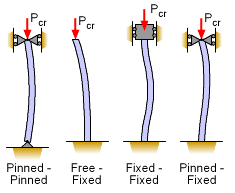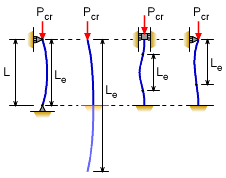| Ch 9. Columns | Multimedia Engineering Mechanics | ||||||
|
Basic Columns |
Fixed Columns |
Eccentric Loads |
|||||
| Fixed Columns | Case Intro | Theory | Case Solution | Example |
| Chapter |
| 1. Stress/Strain |
| 2. Torsion |
| 3. Beam Shr/Moment |
| 4. Beam Stresses |
| 5. Beam Deflections |
| 6. Beam-Advanced |
| 7. Stress Analysis |
| 8. Strain Analysis |
| 9. Columns |
| Appendix |
| Basic Math |
| Units |
| Basic Mechanics Eqs |
| Sections |
| Material Properties |
| Structural Shapes |
| Beam Equations |
| eBooks |
| Dynamics |
| Fluids |
| Math |
| Mechanics |
| Statics |
| Thermodynamics |
| ©Kurt Gramoll |
|
|
||||||||||||||
| Column Buckling |
||||||||||||||
|
|
Besides the basic pinned-pinned (simply supported) column, there are other types of column boundary conditions. A column can be fixed at one or both ends, and if one end is fixed, then the other can be free. Each of these basic column types (shown at the left) can be solved in a similar fashion as the pinned-pinned column by developing a differential equation and then solving it using the end conditions. (The derivations are omitted since they are similar to the simply support column case presented previously.) The basic column types are given below with their critical load equation. |
|||||||||||||
|
||||||||||||||
|
Alternate Buckling Equation Formulation |
|||||||||||||
|
The four buckling equations given above can be summarized into one equation using the concept of equivalent length (sometimes referred to as effective length). Each of the four buckled column types have a similar buckling shape for a given part of their length. These similar shapes are noted in the diagram as Equivalent Length, Le. Using this equivalent length, Le, a single buckling equation can be used for all four column types.
|
||||||||||||||
| Slenderness Ratio, Le/r |
||||||||||||||
|
|
As a column height is reduced, the critical buckling load increases. This relationship can be seen if the basic Euler formula, Pcr = π2EI/L2, is graphed. To make it easier to plot this function, it can be rewritten using the definition of the radius of gyration, r, which is r = (I/A)0.5 [note, this is not the radius] Substituting, gives
|
|||||||||||||
 Euler Curve for
Euler Curve for Various Stiffness Values |
This function is only accurate in predicting buckling for slender columns. While each material is different, a slenderness ratio of 100 or greater will generally fail due to buckling. For columns with a slenderness ratio less than 100, the material may fail in compression and the yield stress must be check in addition to buckling. As demonstrated with the simulation on the left, the value of E, stiffness, has little effect on the general shape of the Euler curve. |
|||||||||||||
Practice Homework and Test problems now available in the 'Eng Mechanics' mobile app
Includes over 500 free problems with complete detailed solutions.
Available at the Google Play Store and Apple App Store.



